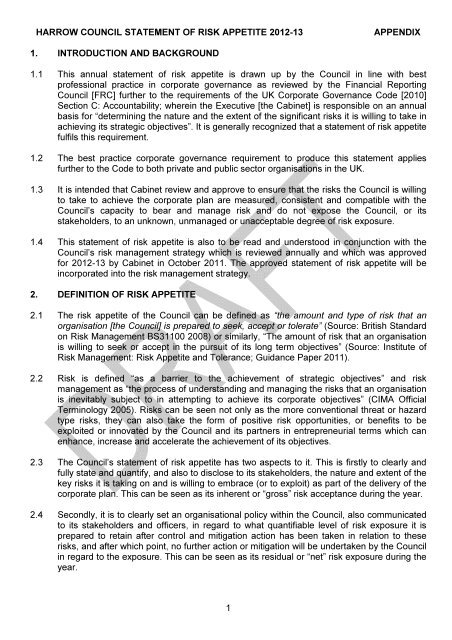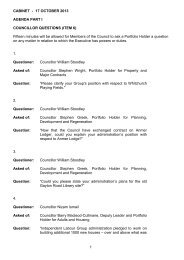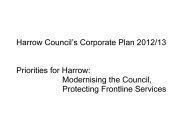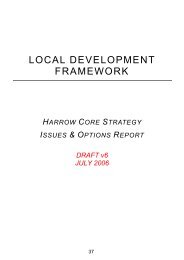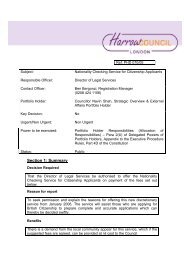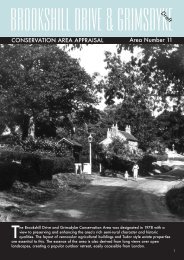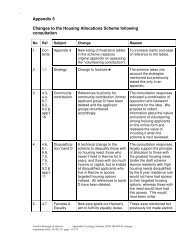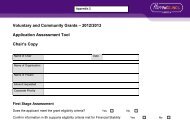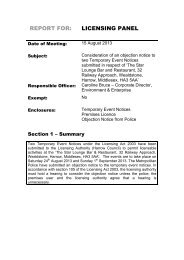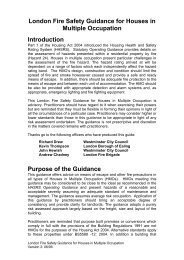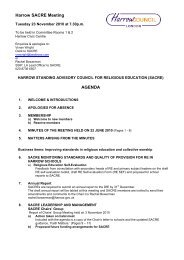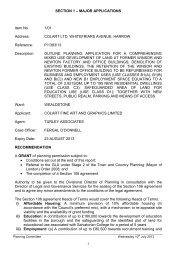Risk Appetite Statement PDF 365 KB - Harrow Council
Risk Appetite Statement PDF 365 KB - Harrow Council
Risk Appetite Statement PDF 365 KB - Harrow Council
Create successful ePaper yourself
Turn your PDF publications into a flip-book with our unique Google optimized e-Paper software.
HARROW COUNCIL STATEMENT OF RISK APPETITE 2012-13APPENDIX1. INTRODUCTION AND BACKGROUND1.1 This annual statement of risk appetite is drawn up by the <strong>Council</strong> in line with bestprofessional practice in corporate governance as reviewed by the Financial Reporting<strong>Council</strong> [FRC] further to the requirements of the UK Corporate Governance Code [2010]Section C: Accountability; wherein the Executive [the Cabinet] is responsible on an annualbasis for “determining the nature and the extent of the significant risks it is willing to take inachieving its strategic objectives”. It is generally recognized that a statement of risk appetitefulfils this requirement.1.2 The best practice corporate governance requirement to produce this statement appliesfurther to the Code to both private and public sector organisations in the UK.1.3 It is intended that Cabinet review and approve to ensure that the risks the <strong>Council</strong> is willingto take to achieve the corporate plan are measured, consistent and compatible with the<strong>Council</strong>’s capacity to bear and manage risk and do not expose the <strong>Council</strong>, or itsstakeholders, to an unknown, unmanaged or unacceptable degree of risk exposure.1.4 This statement of risk appetite is also to be read and understood in conjunction with the<strong>Council</strong>’s risk management strategy which is reviewed annually and which was approvedfor 2012-13 by Cabinet in October 2011. The approved statement of risk appetite will beincorporated into the risk management strategy.2. DEFINITION OF RISK APPETITE2.1 The risk appetite of the <strong>Council</strong> can be defined as “the amount and type of risk that anorganisation [the <strong>Council</strong>] is prepared to seek, accept or tolerate” (Source: British Standardon <strong>Risk</strong> Management BS31100 2008) or similarly, “The amount of risk that an organisationis willing to seek or accept in the pursuit of its long term objectives” (Source: Institute of<strong>Risk</strong> Management: <strong>Risk</strong> <strong>Appetite</strong> and Tolerance; Guidance Paper 2011).2.2 <strong>Risk</strong> is defined “as a barrier to the achievement of strategic objectives” and riskmanagement as “the process of understanding and managing the risks that an organisationis inevitably subject to in attempting to achieve its corporate objectives” (CIMA OfficialTerminology 2005). <strong>Risk</strong>s can be seen not only as the more conventional threat or hazardtype risks, they can also take the form of positive risk opportunities, or benefits to beexploited or innovated by the <strong>Council</strong> and its partners in entrepreneurial terms which canenhance, increase and accelerate the achievement of its objectives.2.3 The <strong>Council</strong>’s statement of risk appetite has two aspects to it. This is firstly to clearly andfully state and quantify, and also to disclose to its stakeholders, the nature and extent of thekey risks it is taking on and is willing to embrace (or to exploit) as part of the delivery of thecorporate plan. This can be seen as its inherent or “gross” risk acceptance during the year.2.4 Secondly, it is to clearly set an organisational policy within the <strong>Council</strong>, also communicatedto its stakeholders and officers, in regard to what quantifiable level of risk exposure it isprepared to retain after control and mitigation action has been taken in relation to theserisks, and after which point, no further action or mitigation will be undertaken by the <strong>Council</strong>in regard to the exposure. This can be seen as its residual or “net” risk exposure during theyear.1
HARROW COUNCIL STATEMENT OF RISK APPETITE 2012-13APPENDIX2.5 Generally organisational attitudes to risk, including public sector organisations, can be saidto range across a spectrum of attitudes and appetites, ranging from Low <strong>Risk</strong> or riskaverseappetites at one end of the scale (here there is avoidance of any form of risk anduncertainty as a key organizational objective) through to an intermediary Medium <strong>Risk</strong> orcautious approach to risk (here the organisation’s preference is for safe delivery optionsthat have a low degree of inherent risk) then ranging to a High <strong>Risk</strong> or risk-seekingposition (the organisation is innovative and chooses service delivery options offering highercustomer satisfaction/quality despite greater inherent risk in these activities).2.6 It is important to note that gross risk appetites may often vary across different types of riskat different times, and may even vary across directorates in these terms and that anorganisation’s overall gross risk appetite is often a composite or aggregate of thesedifferent risk appetites.2.7 The range or spectrum of risks comprising significant risk is commonly defined as beingmade up of five major categories of risk - strategic, financial, service delivery/business risk,legal and finally reputation risks. These are outlined in greater detail below.3. THE COUNCIL’S RISK APPETITE IN 2012-133.1 During 2012-13 the <strong>Council</strong> will have in the main an overall and informed cautious appetitefor taking significant risk to achieve the corporate plan and for delivering council services insupport of this. Where significant risks arises the <strong>Council</strong> and its officers will take effectivecontrol action to mitigate these risks to minimal and safe levels of net residual risk exposurefor stakeholders.3.2 However it is to be noted that whilst the <strong>Council</strong> will maintain its overall informed cautiousapproach, it will have areas within this where a higher level of risk will be taken such as in,for example, in supporting innovation in service delivery. These will be offset by areaswhere it maintains a lower than cautious appetite such as in, for example, matters ofcompliance with law and public confidence in the <strong>Council</strong>, so leading to its overall andinformed cautious position on risk.3.3 The Cabinet also accepts in regard to the taking of risk that there may often be early failureand set-back in the longer term process of obtaining the returns and outcomes fromdelivery of the corporate plan, particularly in regard to developing new and innovativeprocesses at the <strong>Council</strong> necessary to achieve the plan.3.4 The Cabinet will therefore be supportive to all council officers in the taking of necessary,calculated and measured risk in order that the objectives the <strong>Council</strong> has set for itself in thecorporate plan can be achieved during this time of increasing financial austerity, challengeand change.3.5 The nature and main types of significant risk as mentioned above that the <strong>Council</strong> will takeon as part of its risk portfolio in 2012-13 will be as follows:-(a). Strategic <strong>Risk</strong>(b). Financial <strong>Risk</strong>(c). Service Delivery/Business <strong>Risk</strong>(d). Legal and Compliance <strong>Risk</strong>(e). Reputation <strong>Risk</strong>2
HARROW COUNCIL STATEMENT OF RISK APPETITE 2012-13APPENDIX3.6 These risks can be defined as follows:-Strategic <strong>Risk</strong>This is the risk arising from the possible consequences of strategic decisions taken by the<strong>Council</strong>, or the risk of a failure to achieve corporate priorities, and should be identified andassessed at the Executive and senior management level of the <strong>Council</strong>.Financial <strong>Risk</strong>This is the risk of changes in the <strong>Council</strong>’s financial condition and circumstances, such asfor example, in its balance sheet assets and liabilities, its funding, income and spendinglevels.Service Delivery/Business <strong>Risk</strong>This is the risk arising from the nature of the <strong>Council</strong>’s business and operations, forexample, the risk of a failure to deliver statutory or other services to residents, to fail toprovide required quality in services, or to fail to provide appropriate services in the event ofan emergency.Legal and Compliance <strong>Risk</strong>This is the risk of successful legal action being taken against the <strong>Council</strong>, or of the <strong>Council</strong>breaching law in its activities and operations, and is also the risk of losses, possibly fines,and other sanctions arising from non-compliance with laws and regulations.Reputation <strong>Risk</strong>This is the risk of a significantly adverse or damaging perception of the <strong>Council</strong> by thegeneral public and <strong>Harrow</strong> residents.3.7 The <strong>Council</strong>’s appetite for these risks on a net residual risk basis can thus be showngraphically in overall summary terms as follows:-Diagram 1: <strong>Council</strong> Net Residual <strong>Risk</strong> <strong>Appetite</strong> for Significant <strong>Risk</strong> in 2012-13Net Residual <strong>Risk</strong> <strong>Appetite</strong> for Significant <strong>Risk</strong><strong>Risk</strong> <strong>Appetite</strong> LevelHighMedLowStrategic<strong>Risk</strong>Financial<strong>Risk</strong>ServiceDelivery <strong>Risk</strong> Compliance<strong>Risk</strong>Significant <strong>Risk</strong>Reputation<strong>Risk</strong>3
HARROW COUNCIL STATEMENT OF RISK APPETITE 2012-13APPENDIX4. THE CORPORATE PLAN AND THE NATURE AND MAIN TYPES OF SIGNIFICANTRISK BEING TAKEN ON BY THE COUNCIL IN 2012-134.1 <strong>Harrow</strong> <strong>Council</strong> provides a wide range of services that improve the quality of life forresidents, support vulnerable people and which enhance community cohesion. Over thelast five years, the quality of those services has improved from in some areas being lowerquartilein terms of <strong>Council</strong>s in London to being awarded the title of best achieving <strong>Council</strong>in the UK in the Municipal Journal awards in June 2011. The <strong>Council</strong>’s key riskmanagement challenge is to maintain and advance its excellent services while at the sametime managing significant reductions in its spending power. The <strong>Council</strong>’s corporatepriorities are:• Keeping neighbourhoods clean, green and safe;• United and involved communities: a <strong>Council</strong> that listens and leads;• Supporting and protecting people who are most in need; and• Supporting our Town Centre, our local shopping centres and businesses;4.2 These will help the <strong>Council</strong> decide how to best allocate and manage its reducing resources.The <strong>Council</strong> will work in strong collaboration with its partners and in its communities indemonstrating its vision: Working Together; Our <strong>Harrow</strong>, Our Community. During 2012-13and beyond the <strong>Council</strong> will continue to look for efficiency savings to meet the exactingfinancial targets set by Government. As well as looking at all services to seek better waysof achieving agreed outcomes, the scale of the savings required has placed additionalemphasis on the need for transformational change, that is, changing completely the way inwhich the <strong>Council</strong> delivers its services and how it involves it partners. The landscape andrange of transformational change includes:• consideration of the <strong>Council</strong>’s growing role as a commissioning organisation;• implementing earlier interventions to improve the quality of life of, for example,vulnerable adults and children ,families with complex needs, and reducing their callon public services;• Participating in schemes to reduce re-offending to reduce the social cost of crime;• Developing common assessment and service signposting with partners to improveaccess to services and reduce the costs of multiple assessments;• Reducing the number of public buildings used to deliver services in <strong>Harrow</strong>• Considering a common combined access point for more if not all public services.4.3 The appetite for significant risk as defined above, on a “gross” or inherent risk basis, and ona directorate by directorate basis (this produced further to direct engagement of corporatedirectors on their directorate’s risk appetite) is outlined below:-4
HARROW COUNCIL STATEMENT OF RISK APPETITE 2012-13APPENDIXDiagram 2: <strong>Appetite</strong> for Acceptance of Strategic <strong>Risk</strong>HighStrategic <strong>Risk</strong> <strong>Appetite</strong><strong>Risk</strong> <strong>Appetite</strong>MedLowA d u l t s & H o u s i n gC h i l d r e n ' s S e r v i c e sDirectoratesC o m m u n i t y a n d E n v i r o n m e n tP l a c e S h a p i n gL e g a l a n d G o v e r n a n c eC h i e f E x e c u t i v e ' sC o r p o r a t e F i n a n c eDiagram 3: <strong>Appetite</strong> for Acceptance of Financial <strong>Risk</strong>Financial <strong>Risk</strong> <strong>Appetite</strong>High<strong>Risk</strong> <strong>Appetite</strong>MedLowAdults &HousingChildren'sServicesCommunityandEnvironmentPlaceShapingLegal andGovernanceChiefExecutive'sCorporateFinanceDirectorate5
HARROW COUNCIL STATEMENT OF RISK APPETITE 2012-13APPENDIXDiagram 4: <strong>Appetite</strong> for Acceptance of Service Delivery <strong>Risk</strong>Service Delivery <strong>Risk</strong> <strong>Appetite</strong>High<strong>Risk</strong> <strong>Appetite</strong>MedLowAdults &HousingChildren'sServicesCommunityandEnvironmentPlaceShapingLegal andGovernanceChiefExecutive'sCorporateFinanceDirectorateDiagram 5: <strong>Appetite</strong> for Acceptance of Legal and Compliance <strong>Risk</strong><strong>Appetite</strong> for Legal and Compliance <strong>Risk</strong>High<strong>Risk</strong> <strong>Appetite</strong>MedLowAdults &HousingChildren'sServicesCommunityandEnvironmentPlaceShapingLegal andGovernanceChiefExecutive'sCorporateFinanceDirectorate6
HARROW COUNCIL STATEMENT OF RISK APPETITE 2012-13APPENDIXDiagram 6: <strong>Appetite</strong> for Acceptance of Reputation <strong>Risk</strong><strong>Appetite</strong> for Reputational <strong>Risk</strong>High<strong>Risk</strong> <strong>Appetite</strong>MedLowAdults &HousingChildren'sServicesCommunityandEnvironmentPlaceShapingLegal andGovernanceChiefExecutive'sCorporateFinanceDirectorate4.4 The <strong>Council</strong>’s appetite for significant risk when collaborating with its partner organisationscan be shown below:-Diagram 7: Our Partnership <strong>Appetite</strong> for the Acceptance of Significant <strong>Risk</strong>Partnership <strong>Appetite</strong> for Significant <strong>Risk</strong>High<strong>Risk</strong> <strong>Appetite</strong>MedLowStrategic<strong>Risk</strong>Financial<strong>Risk</strong>ServiceDelivery <strong>Risk</strong>Legal andCompliance<strong>Risk</strong>Reputational<strong>Risk</strong>Type of <strong>Risk</strong>7
HARROW COUNCIL STATEMENT OF RISK APPETITE 2012-13APPENDIX4.5 The above risks are normal and consequential for the <strong>Council</strong> in conducting its businessand delivering services across its directorates. They are generated in strategic andbusiness terms by the ambition for and the delivery of the corporate plan and organisationaltransformation, and exist with strong reference to the now challenging macroeconomic andmicroeconomic environment in the UK, including centrally the levels of government fundingand required spending reductions in the public sector. These factors have increased thelevel of total business risk required to be taken on by the <strong>Council</strong> in order to deliver itscorporate plan.4.6 Consequently in 2012-13 the <strong>Council</strong> will be accepting and taking on additional andincreased levels of inherent risk than in previous years and in this respect now has a highergross risk acceptance appetite.4.7 However it believes that over 2012-13 and beyond, it has the leadership, resilience,financial discipline, organisational capacity, capability and control environment in place toenable it to safely bear this higher level of risk and to manage and mitigate it downwards toappropriate and acceptable levels of net residual risk exposure consistent with a localauthority.5. NET RISK LEVELS TO BE RETAINED BY THE COUNCIL IN 2012-135.1 Whilst the different types of risk above will commonly have different risk appetites and theappetites may vary from directorate to directorate, it is rare for any significant risk facing the<strong>Council</strong> to be purely composed of just one type of risk above, or to relate solely in impact tojust one directorate. Most significant and large scale risks will be commonly composed ofseveral risk dimensions and often have a relationship and inter-dependency in impact andlikelihood terms with other risks and directorates.5.2 The unifying factor in the <strong>Council</strong>’s key, potentially large-scale and significant risks, are thatthey are inter-related in this way and form part of a wider collection of risks and riskexposure to the <strong>Council</strong>.5.3 Management of this key exposure is most effective and efficient when undertaken incommon and collective terms, rather than on an individual risk by risk basis or appetite byappetite basis varying across different directorates. For this reason all of the above <strong>Council</strong>significant risk types will be subject to the same managed down net risk appetite level,which will itself be risk-based, and will be driven by the significance and scale of the riskconcerned and whether that significance is high, medium or low.5.4 As mentioned above net risk is the final level of exposure of unguarded and unprotectedrisk the <strong>Council</strong> is willing to take and so at this point exercise the “do-nothing” option inregard to the risk.5.5 The <strong>Council</strong>’s net risk appetite for negative threat risks (as opposed to positive opportunityrisks) is shown below by the bolded risk appetite/target risk rating line in the <strong>Council</strong>’sstandard risk register template attached at Annex A of this Appendix :-8
HARROW COUNCIL STATEMENT OF RISK APPETITE 2012-13APPENDIXDiagram 8: <strong>Risk</strong> <strong>Appetite</strong> for Negative Threat <strong>Risk</strong>s<strong>Council</strong> <strong>Risk</strong> Register Template<strong>Risk</strong> LikelihoodA Very High(>80%) <strong>Risk</strong> AB High(51-80%)C Significant(25-50%)D Low(10-24%)E Very Low(3-9%)F Almost Impossible(0-2%)<strong>Risk</strong> Impact4. NegligibleImpact orBenefit<strong>Risk</strong> C<strong>Risk</strong> D<strong>Risk</strong> F3.MarginalImpact orMinorBenefit2.CriticalImpact orMajorBenefit<strong>Risk</strong> B<strong>Risk</strong> E1.CatastrophicImpact orExceptionalBenefit9Line of <strong>Risk</strong> <strong>Appetite</strong>/Target <strong>Risk</strong> Rating5.6 All risks which appear above the risk appetite line are deemed unacceptable to be carriedby the <strong>Council</strong> in residual or target risk terms and will require management review andaction by officers of the <strong>Council</strong>. Management must ensure control action taken issufficient, balanced and comprehensive enough to achieve the target risk appetite rating. Inthe above example <strong>Risk</strong>s A and B are unacceptable. <strong>Risk</strong>s at an exposure below the lineare deemed acceptable. In the above example <strong>Risk</strong>s C, D, and E are deemed acceptable.5.7 However in the area beneath the line, in which risks are acceptable, if there is any markedor significant variation or distance from the actual line of risk appetite then this could lead tothe risk being disproportionately over managed to a level which is again effectively outsideof the <strong>Council</strong>’s risk appetite. In the above example <strong>Risk</strong> F has been over managed. This isbecause a marginal or relatively scale small risk should it impact has been managed inresource terms to an almost impossible level of likelihood and this is disproportionate to therisk being faced.5.8 The <strong>Council</strong> thus recognizes that all risks should not be managed to the same extent but itshould be noted further to the line of risk appetite that all significant risk (ie critical orcatastrophic) will in all circumstances where possible be managed down to a low or verylow net target risk exposure. Where, however, the risk is deemed to be of lesser scale thancritical or catastrophic, a higher degree of residual risk exposure and lesser levels ofmitigation (enabling a higher degree of measured and entrepreneurial risk-taking inbusiness terms by officers) will be encouraged further to the pursuit of our corporatepriorities.5.9 Where a residual or target risk level is in excess of the risk appetite exposure of the <strong>Council</strong>as indicated above, the risk must further to the <strong>Council</strong>’s risk management strategy be
HARROW COUNCIL STATEMENT OF RISK APPETITE 2012-13APPENDIXescalated to the next management level for discussion, as part of normal risk reporting, e.g.department to division, division to directorate, improvement board to directorate level(project risks to the relevant project or programme and/or directorate boards) and,ultimately, from directorate level to the Corporate Strategic Board (CSB) of the <strong>Council</strong>. Theframework for the reporting and escalation of risks within the <strong>Council</strong> is based on theorganisational structure and normal reporting lines. As part of the escalation process, thenext management level of the <strong>Council</strong> will be alerted to the risk and will therefore reviewand reassess it in terms of its impact and likelihood on the achievement of objectives at thatnext level and will take action as appropriate. This may mean:-• managing the risk directly in terms of its mitigation and control• adjusting the level of risk they judge suitable for the level below to manage• transferring the risk, if possible, appropriate, or cost effective to do so• changing the activity giving rise to the risk or exiting the activity giving rise to the risk5.10 The <strong>Council</strong>’s risk appetite for positive opportunity risks will similarly be risk-based andshown below with reference to the standard risk register template:-Diagram 9: <strong>Risk</strong> <strong>Appetite</strong> for Positive Opportunity <strong>Risk</strong>s<strong>Council</strong> <strong>Risk</strong> Register TemplateLikelihoodA Very High(>80%)OPP CB High(51-80%)OPP FOPP DC Significant(25-50%)OPP EOPP AD Low(10-24%)OPP BE Very Low(3-9%)F AlmostImpossible (0-2%)Impact4. NegligibleImpact orBenefit3.MarginalImpact orMinor Benefit2. CriticalImpact orMajor Benefit1.CatastrophicImpact orExceptionalBenefitLine of <strong>Risk</strong> <strong>Appetite</strong>/Target <strong>Risk</strong> Rating for Positive <strong>Risk</strong> Opportunities5.11 All opportunities which appear below the risk appetite line are not being fully exploited andwill require management action by officers of the <strong>Council</strong> in order to more fully exploit themand move them to a position of realization. In the above example Opportunities A and B areunacceptable for this reason. Opportunities managed to a level above line are deemedacceptable because they are being exploited in line with the <strong>Council</strong>’s opportunity riskappetite. In the above example Opportunities C, D and E are deemed acceptable.10
HARROW COUNCIL STATEMENT OF RISK APPETITE 2012-13APPENDIX5.12 However it is to be noted, as in principle with negative threat risks, that in the areas abovethe line, if there is any marked or significant variation or distance from the actual line ofopportunity risk appetite, then that opportunity is being over managed. Opportunity F in theexample above is being over-exploited as it has been managed to high level of likelihoodwhen it offers only a negligible benefit or reward relative to other opportunities and this isdisproportionate.5.13 In this way management should endeavour to stay above but close to the line ofopportunity risk appetite and should prioritise larger scale opportunities which have areasonable prospect of success over smaller scale opportunities which may have higherlevels of likelihood.5.14 Where a positive risk opportunity is indicated as being managed outside of the <strong>Council</strong>’srisk appetite then this will be escalated as part of normal risk reporting processing to thenext management level for review and action as outlined above in regard to negative threatrisks.5.15 As outlined above, overall the <strong>Council</strong>’s net residual risk appetite for its key and significantrisks in 2012-13 is cautious in broad risk terms as shown below:-Diagram 10: <strong>Council</strong> Net Residual <strong>Risk</strong> <strong>Appetite</strong> for Significant <strong>Risk</strong> in 2012-13Net Residual <strong>Risk</strong> <strong>Appetite</strong> for Significant <strong>Risk</strong><strong>Risk</strong> <strong>Appetite</strong> LevelHighMedLowStrategic<strong>Risk</strong>Financial<strong>Risk</strong>ServiceDelivery <strong>Risk</strong>Significant <strong>Risk</strong>Legal andCompliance<strong>Risk</strong>Reputation<strong>Risk</strong>6. DUTY OF OFFICERS6.1 All of the <strong>Council</strong>’s elected Members and its staff and officers, including when they areworking in partnership with other organisations, have a general duty and responsibility aspart of their actions and agencies on behalf of the <strong>Council</strong> to manage risk as an integralpart of their role, which includes ensuring they comply at all times with the framework andprovisions of the risk appetite of the <strong>Council</strong> as outlined in this document.11
HARROW COUNCIL STATEMENT OF RISK APPETITE 2012-13APPENDIX7. MONITORING OF ORGANISATIONAL COMPLIANCE7.1 Compliance with this risk appetite statement will be regularly monitored and reported on anon-going basis to CSB by the corporate risk management function as part of normal riskreporting, supported by the Corporate <strong>Risk</strong> Steering Group (CRSG), the <strong>Council</strong>’sdirectorate-wide risk champion’s forum, acting in its monitoring and challenging role inregard to risk management arrangements.7.2 Compliance will also be further monitored by the GARM committee of Members whomonitor and challenge risk management activities and progress at the <strong>Council</strong>.7.3 Compliance will also be audited by the <strong>Council</strong>’s internal audit function and also as part the<strong>Council</strong>’s arrangements for production of the Annual Governance <strong>Statement</strong>.12
HARROW COUNCIL STATEMENT OF RISK APPETITE 2012-13 APPENDIXStandard <strong>Risk</strong> Register Template Annex ARISK RIGISTERReview Date:Next Review Date:<strong>Risk</strong>s1.2.3.4.5.6.7.8.9.10.LIKELIHOODA VeryHigh(>80%)B High(51-80%)CSignificant(25-50%)D Low(10-24%)(10-24%)E VeryLow(3-9%)IMPACT4NegligibleImpact /Benefit3MarginalImpact /MinorBenefit2CriticalImpact /MajorBenefit1Catastrophic Impact /Exceptional Benefit13
HARROW COUNCIL STATEMENT OF RISK APPETITE 2012-13 APPENDIXStandard <strong>Risk</strong> Register Template Annex A (Cont’d)<strong>Risk</strong> No.Objective No.<strong>Risk</strong> DescriptionControls(in place and effective)<strong>Risk</strong>RatingThisQtr(aftercontrols)<strong>Risk</strong>RatingLastQtrControls(underway or planned)ControlProgress%Target<strong>Risk</strong>RatingTarget<strong>Risk</strong> Date<strong>Risk</strong> OwnerConsequence(s)ContingenciesCause(s)<strong>Risk</strong> (Event)Further actions14


